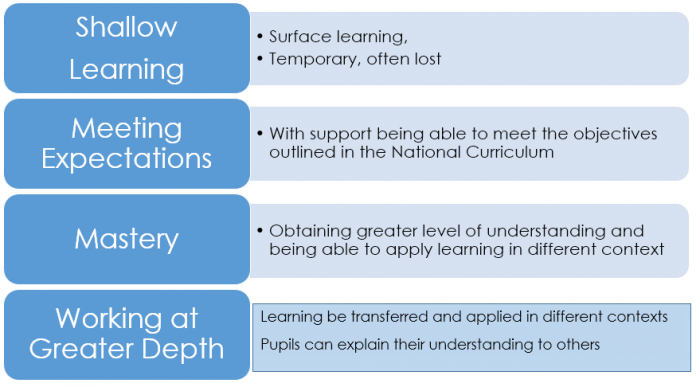What are unit tests, when should we use them, how are they done and what do they tell us?
The following are statements and an explanation of the current new system….
The new world of ‘assessment without levels’ is intended to encourage a more professional, intelligent assessment. There is a recognition that learning is neither neat nor linear. The simple attachment of a level could undermine learning as there could be gaps in specific areas of learning for a child. Progression is more focused on understanding and developing greater depth in the national curriculum than on mere progression to the next set of content.
This diagram helps to clarify the concept of mastery and greater depth in the national curriculum:
The problem is that in attempting to encourage more professional intelligent assessment the new system actually presents a vague and subjective analysis which is impossible to interpret without copious supportive materials.
This is further compounded by the fact that the actual DFE tests present a numerical pass and fail grade and scores accordingly. For the above to be of any use then the DFE would have to abandon SAT’s testing and rely totally on record keeping and reporting according to the above statements. In presenting a numerically scored SAT’s test the DFE simply presents a written test for children which is marked and graded…..bit like before really but without the levels!
Tracking – pupil tracking is a hot topic at the moment. Just how well are the children doing and how are they progressing? The vast majority of schools give tests for this….marked and graded tests. Some schools test termly and others half termly – with the results being interpreted and plotted on whichever system the school has chosen to use.
However, having obtained a numerical score- just how are these to be interpreted? Should they be plotted simply as scores….pass or fails…matched to the statements above or converted to the DFE scaled scores?
You see the abolition of the levels (3A, 4C etc ) has left a kind of limbo. It is all very well to present these statements of attainment yet they have no use in pupil tracking nor in progress monitoring. For this to occur you need a numerical system – and there is now no common ground on this and schools can do what they wish.
DFE scaled scores are, in my opinion, the way to go. They have set the approach towards the final national / school assessment procedures and levels and it is to this system that we should align our own. I am not, here, going to explain how this can be achieved – suffice to say that it is not a complex thing to do and can be used across the school and may be used to track attainment and progress at any level.
I had a question some time ago from a school assessment leader. The school had recently a new Headteacher and they wanted to be able to track the progress of pupils. Unfortunately the school only currently had the statement levels for pupils and the new HT quite rightly wanted more to work with. Basically the HT wanted numbers…assessment scores and results which he could work with, present, plot and track.

Finally we come to UNIT TESTS!
As I said earlier, there is a need for a quantifiable system of assessing children’s knowledge and progress and the inclusion of unit tests within any school system adds to the workable knowledge of both the teacher and school.
Unit tests are a very simple way of summarising the work covered in a unit and act as a check on the success of that unit.
The basic features of a unit test are as follows…
- A simple test based on the working knowledge and skills contained in the unit
- Dependent on age the test can run from 10 minutes to 30 minutes
- The test should be progressive in difficulty and as such accessible at some level by all children
- It may be paper based or contain some use of practical equipment
- It should be done under test conditions
- The test should be marked and graded – in addition, scores should also be presented as a %

Not only do these simple tests reflect the unit taught but they also give you as a teacher vital information in addition to that obtained during the units teaching. If these results are converted to % then they can be directly converted to the DFE scaled scores and comparative results obtained.
Don’t sweat it!
I am a big fan of unit tests – I am also a big fan of mark books and grading marked work! But whichever approach you use to the marking of your work; there is a place, I think, for the unit test.
There is no need for this to become an onerous thing to do. Yes I can hear some colleagues stating that it is more work… but really? how much more?
The test questions you choose are based on what the unit contains – there is no need for fancy computer designed test papers, in fact you could write it in biro and photocopy it, so long as it is legible!
As for marking – well how many questions will you set for a (let’s say) 20 minute test and how long will that take to mark…the answer is very little time. But the resultant scores and levels are just what you need to backup and report on the children’s progress.
Personally, from a purely “covering your own back” point of view, I think it’s gold; but from a teaching and learning point of view its a direct measure of the progressive knowledge and skill development for all the children in your class.




